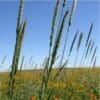Dahurian Wildrye (Elymus dahuricus) is an introduced, self- pollinating, short-lived (1-3 yrs) perennial bunchgrass. It is native to Siberia, Mongolia and China. In North America it has been used in pasture and hay production in western Canada from Saskatchewan to British Columbia. It is adapted to sites receiving 12 to 24 inches annual precipitation, but persists longer with higher precipitation. It is said to have high saline tolerance and is adapted to all soil textures. It was grown in test plots in Saskatchewan with electrical conductivity levels up to 6.7 dS/m. It is not as winter hardy as crested or intermediate wheatgrass in semi-arid climates with little snow cover. It is very competitive during establishment but loses competitive ability as the stand ages. It establishes quickly and has high seedling vigor, making it a good candidate for reclamation or quick pasture.
Dahurian wildrye is a tall plant with leaves growing high up on the stem providing excellent forage for pasture. It also has better regrowth after harvest than intermediate and crested wheatgrass and can be grazed 2 to 3 times per season. It produces significantly greater amounts of forage than crested and intermediate wheatgrass in the first growing season but decreases as stands lose vigor in subsequent years. Forage quality and palatability of Dahurian wildrye is high, comparable to intermediate and crested wheatgrass. It is a short-lived perennial with quick establishment and is used as an early forage component with other slower growing species. Because it regrows quickly after harvesting it has a better yield distribution than other forage grasses.
Dahurian wildrye has exceptional grazing recovery. It can be grazed in early spring without negative effects. However Dahurian wildrye has a shallow root system and plants can be pulled easily from the ground in wet spring soils during the establishment year. New seedings should be protected from grazing until they are well established.
Dahurian Wildrye is a common component in our dryland pasture mixes, especially custom mixes were fast establishment and heavy initial grazing are the bill.
***Click on the “Quick Plant Facts” tab above for more information.
Dahurian Wildrye NRCS Fact Sheet and Plant Guide
Dahurian Wildrye NRCS Fact Sheet and Plant Guide
PDF version of NRCS Plant Guide & Fact Sheet
Citation: Tilley, D. and L. St. John. 2014. USDA-Natural Resources Conservation Service, Aberdeen Plant Materials Center. Aberdeen, Idaho 83210.
Helpful Links
Additional information about this product can be found on the academic websites linked below.
Synonyms
Many plants have more than one common and scientific name. We've listed a few of them below.
- Dahurian Wildrye
- Elymus dahuricus
Who is Great Basin Seed?
Great Basin Seed is a seed company that specializes in seed sales and consultation for home, ranch, farm, range and reclamation. We have been a leader in the seed industry since 1974.
Our History
We've been in the seed business since 1974.
What We Offer
We offer seed for home, farm, ranch, range and reclamation projects.
Meet the Gang
We have the best employees in the world! We are proud of the work they do, and trust them to serve you!
Right: Company founder Lloyd and his wife Paula Stevens in a wildflower seed production field circa 1977
Quick Plant Facts
| Common Name: | Dahurian Wildrye |
|---|---|
| Scientific Name: | |
| Lifespan: | |
| Origin: | |
| Plant Type: | |
| pH Tolerance: | |
| Seeds per Pound: | |
| Growth Height: | |
| Root Form: | |
| Planting Rate: | |
| Min. Precipitation: | |
| Best Time to Sow: | |
| Max Sowing Depth: | |
| Growth Season: | |
| Sun & Shade Tolerance: | Full Sun |
| Elevation of Occurance: | |
| Hardiness Zones: |





